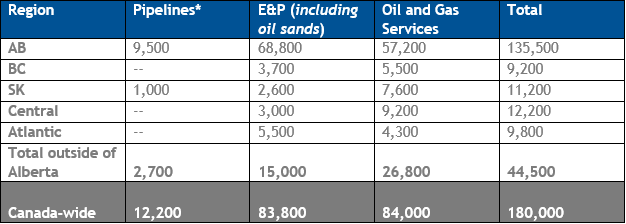2019 employment in Canada’s oil and gas industry
- 3 min read
PetroLMI has released December 2019 data from Statistics Canada’s Labour Force Survey (LFS)*, providing a glimpse into the state of the labour market at year-end. The oil and gas industry employed approximately 180,000 workers across Canada in December 2019, down 10 per cent from 197,700 in December 2018.
*LFS is a sample survey and all estimates are subject to sampling and non-sampling errors.
A leaner workforce
The industry has become leaner in response to a lengthy industry downturn, shrinking from a peak of about 229,000 jobs in August 2014. The workforce continues to be influenced by declines in capital spending, low commodity prices and uncertainty over market access. Until such time as additional export capacity becomes available, the employment outlook for Canada’s oil and gas sector will continue to be impacted.
According to the December 2019 Labour Force Survey data, the oil and gas industry had lost 17,660 direct jobs from December 2018 from the exploration and production (including oil sands), pipeline transportation and oil and gas services sub-sectors. Job losses occurred mainly in Alberta, with more than 15,100 positions eliminated in the province, down 10 per cent from December 2018 when industry employed 150,600 workers.
More than half of the jobs lost in Canada were from the pipeline transportation sub-sector, with 9,600 positions eliminated, with an almost equal split of about 4,000 jobs lost from both the exploration and production (E&P) and oil and gas services sub-sectors.
When comparing the data with the PetroLMI 2019 Oil and Gas Labour Market Update forecast, the Labour Force Survey (LFS) data reported approximately 5,000 more jobs lost than PetroLMI projected. However, PetroLMI’s 2018 labour force estimate was also lower than the December 2018 LFS data.
Canada, Year-over-Year Comparison, Employment Actuals at December 2018 and 2019, and Annual Forecast

Regional highlights
More than 43,000 Canadians were employed in the oil and gas industry outside of Alberta in December 2019. Most workers were employed by the oil and gas services sub-sector (26,600 or 63%), except for in Atlantic Canada, where 56% of its 9,800 workers worked in the E&P sub-sector. Central Canada had the highest number of workers regionally (outside of Alberta) at 12,200, of which 75% were employed in the oil and gas services sub-sector.
In Saskatchewan and British Columbia, the oil and gas services sub-sector was dominant, employing 68% and 60% of the industry workers in each province, respectively.
Regional Employment by Sub-sector, December 2019

The oil and gas industry employed 172,000 full-time and 8,100 part-time workers across all three sub-sectors in December 2019. Virtually all workers employed in the pipeline transportation sub-sector were full-time employees. Employees make up the majority of total employment in the oil and gas industry (165,200 or 92%) with self-employed workers representing just eight per cent. The oil and gas services sub-sector had the highest number of self-employed workers at 13,000.
Employment Type by Sub-sector, December 2019 – Full-time/Part-time

Employment Type by Sub-sector, December 2019 – Employees/Self-employed

